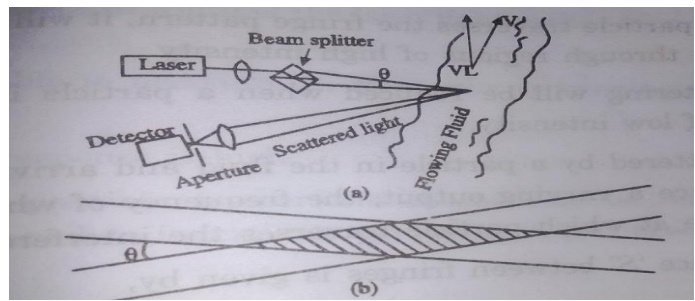Chapter: Fiber optics and Laser instruments : Industrial Applications of Laser
Laser for Measurement of Velocity
Laser for Measurement of Velocity

Principle
Measurement
of the velocity of fluid flow can be performed by scattering a laser beam from
a liquid or gas. The laser beam interacts with smaii particles carried along by
the flowing fluid. The particles scattered light is slightly shifted by the
Doppler effect. The magnitude of the frequency shift is proportional to the
velocity of the fluid.Measurement of the frequency shift directly gives the
flow velocity.
Construction:
The
measurement techniques basically consist of a focusing laser light at a point
within the flowing fluid. Light scattered from the fluid or from particles
entrained within the fluid flow is collected and focused on an optical
detector. Signal processing of the detector output yields the magnitude of the
Doppler frequency shift and hence the velocity of flow.
Working:
The
approach towards measurement is called Dual beam approach. Light from a
continous laser is split into two equal parts by a beam splitter. Ligtv from a
continous laser is split into two equal parts by a beam splitter. The lens
focuses the beam to the same position in the fluid. The place where the two
beams crosses in the fluid, they interfere to form fringes consisting of
alternating regions of high and low intensity.when the particle transverse the
fringe patteren, it will scatter light when it passes through regions of high
intensity.
The scattering will be reduced when a particle is passing through regions of low intensity. Liught scattered by a particles in the fluid and arriving at the detector will produce a varying output, the frequency of which is proportional to the rate at which particle transverses the interferences fringes.
Advantages
No
critical contacts with a fluid. Flow is not disturbed.
Hot or
corrosive fluids can be measured without problems.
The nano
spectral width of the laser light makes accurate measurement possible. It is
possible to measure the flow velocity ranging from cm/s to 100s of m/s. Speed
of response is high.
Makes it
possible to perform measurements related to transient conditions and to
investigate turbulent flow characteristics
Disadvantages
These
require the necessity of having scattering entrained in the fluid. Impossible
to measure flow rate of very cleaned fluid.
Additional
cost is encountered because of the introduction of scattering centers in case
very clean fluids.
It is
possible to seed the flow with scattering particles. But the constraint is that
particles seeded into the flow must be very small so as to follow the flow
faithfully.
Related Topics